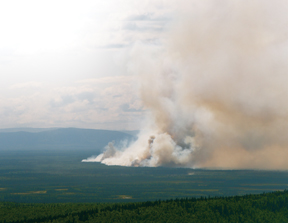|
News Notes
Ecology
Forest fires release mercury
 The most familiar source of mercury in the atmosphere is coal plants. But a hidden mercury threat is lurking as Earth warms: peatlands in the boreal forest regions of the Northern Hemisphere.
The most familiar source of mercury in the atmosphere is coal plants. But a hidden mercury threat is lurking as Earth warms: peatlands in the boreal forest regions of the Northern Hemisphere.
The Parks Highway fire burned more than 100,000 acres in central Alaska last summer, and closed down the highway between Anchorage and Fairbanks for awhile. Research is showing that such boreal forest fires may be releasing large amounts of mercury into the atmosphere. Photograph is by Merritt Turetsky.
Covered in deep layers of organic soils, peatlands in the boreal region have been collecting and storing carbon and mercury since the last ice age, says Merritt Turetsky, a wetland ecologist at Michigan State University in East Lansing. Natural atmospheric circulation patterns have carried mercury from lower latitudes northward, where the peaty soils have sequestered it for millennia.
That sequestration has offset at least some human emissions of mercury, reducing the amount of mercury that could have otherwise fallen into aquatic ecosystems, Turetsky says. But this stockpile of mercury contained in northern peatlands is now under threat — and that’s directly because of climate change, she says.
Turetsky and colleagues measured mercury concentrations and moisture levels in peat as well as water table changes across the region, and tracked forest fires across the boreal region of northwestern Canada over the past few years. They found that as the climate warms across the northern latitudes, thick soil layers at the surface of peatlands dry out, which makes the entire area more susceptible to large fires, Turetsky says. Those fires then release mercury, the team reported in the Aug. 19 Geophysical Research Letters.
For a long time, people thought that peatlands do not burn during forest fires, says Eric Kasischke, a forest ecologist at the University of Maryland in College Park, but Turetsky and others have shown that is not the case, and that mercury becomes mobilized when peat burns. The unanswered question now, he says, is: “How vulnerable will peatlands be to burning in the future?” Quantifying how much of the peatlands burn in large fires may help answer that question, he says.
For now, scientists know that such fires are “increasing dramatically in both intensity and frequency in North American boreal forests,” Kasischke says. In the 1960s, fires burned roughly 1.2 million hectares of North American boreal forests annually, he says. By the 1990s, as temperatures increased, fires were burning 3 million hectares annually.
Models suggest that as droughts increase with rising temperatures, the situation will get worse, Kasischke says. Some estimates suggest that the annual amount of area burned in Canada could double by the end of this century, says Brian Amiro, a soil scientist and fire expert at the University of Manitoba in Winnipeg.
It is also important to understand possible global effects, Amiro says. Turetsky’s colleagues, Hans Friedli and Larry Radke of the National Center for Atmospheric Research in Colorado, have found that 85 percent of the mercury released by northern forest fires is elemental mercury, which can stay in the atmosphere up to a year and travel great distances before settling back to Earth’s surface, Turetsky says. A better understanding of these biogeochemical cycles could lead to better predictions of potential global redistribution, and could aid in evaluating mitigation strategies for reducing any hazardous effects, Amiro says.
But whether boreal regions around the world will suffer the same fate as what has been observed and projected in the boreal forests of North America remains to be seen, Kasischke says. The hydrologic system and landscape varies greatly across boreal forests in North America, Siberia and northern Europe, making it hard to extrapolate data from North America across other regions, he says.
In the end, scientists will need to better understand the size of the expected fires, the amount of mercury that can be released and the height of the smoke plumes, Amiro says — the more vigorous the fire, the higher the plume, and the farther the mercury can be carried around the world.
Megan Sever

 Subscribe
Subscribe

